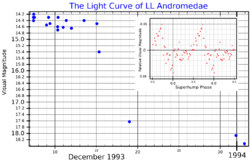Astronomy:LL Andromedae
 The visual band light curve of LL Andromedae, adapted from Kato (2004), is shown. The main plot shows the decay from peak brightness, and the inset plot shows an average of the superhumps.[1] | |
| Observation data Equinox J2000.0]] (ICRS) | |
|---|---|
| Constellation | Andromeda |
| Right ascension | 00h 41m 51.49298s[2] |
| Declination | +26° 37′ 21.0438″[2] |
| Apparent magnitude (V) | 14.3–19.4 variable[1] |
| Characteristics | |
| Variable type | Dwarf nova[3] |
| Astrometry | |
| Proper motion (μ) | RA: 18.319(914)[2] mas/yr Dec.: −18.595(511)[2] mas/yr |
| Parallax (π) | 1.5508 ± 0.6312[2] mas |
| Distance | approx. 2,100 ly (approx. 600 pc) |
| Orbit[4] | |
| Period (P) | 1.32 hours |
| Inclination (i) | 45° |
| Database references | |
| SIMBAD | data |
LL Andromedae (often abbreviated to LL And) is a dwarf nova in the constellation Andromeda, discovered during an outburst in 1979. Its typical apparent visual magnitude is 19.4, but undergoes outbursts events when can reach a peak magnitude of 14.3.[1] Since this magnitude is reached during the most powerful outbursts, while less bright outbursts can occur, it is classified as a SU Ursae Majoris variable.[3]
Variability
The variability of LL Andromedae is similar to the WZ Sagittae type of dwarf novae. Those have a long outbursts cycle (they were observed only in 1979, 1994 and 2004)[5] and superhumps can be observed with a short periodic modulation. It was observed also a periodicity of 1.32 hours, which is attributed to the orbital period of the system. However, in comparison to WZ Sagittae, the outburst amplitude is small and the superoutbursts duration is short.[1]
System
Little is known about the components of LL Andromedae because it's a faint object; one of the two components is likely an accreting white dwarf like in all dwarf novae. A brown dwarf donor has been proposed, but the short periodicity of superhumps hints instead at the presence of a massive companion.[1]
References
- ↑ 1.0 1.1 1.2 1.3 1.4 Kato, T. (March 2004). "1993 Superoutburst of LL Andromedae". Publications of the Astronomical Society of Japan 56: S135–S139. doi:10.1093/pasj/56.sp1.S135. Bibcode: 2004PASJ...56S.135K.
- ↑ 2.0 2.1 2.2 2.3 2.4 Brown, A. G. A. (2021). "Gaia Early Data Release 3: Summary of the contents and survey properties". Astronomy & Astrophysics 649: A1. doi:10.1051/0004-6361/202039657. Bibcode: 2021A&A...649A...1G. Gaia EDR3 record for this source at VizieR.
- ↑ 3.0 3.1 Database entry, Catalog of Cataclysmic Variables (Downes+ 2001-2006), R. A. Downes et al., CDS ID V/123A Accessed on line 2018-11-13.
- ↑ Otulakowska-Hypka, M.; Olech, A.; Patterson, J. (May 1998). "Statistical analysis of properties of dwarf novae outbursts". Monthly Notices of the Royal Astronomical Society 460 (3): 316–320. doi:10.1093/mnras/stw1120. Bibcode: 2016MNRAS.460.2526O.
- ↑ Kato, T.; et, al. (December 2009). "Survey of Period Variations of Superhumps in SU UMa-Type Dwarf Novae". Publications of the Astronomical Society of Japan 61 (sp2): S395–S616. doi:10.1093/pasj/61.sp2.S395. Bibcode: 2009PASJ...61S.395K.
 |
